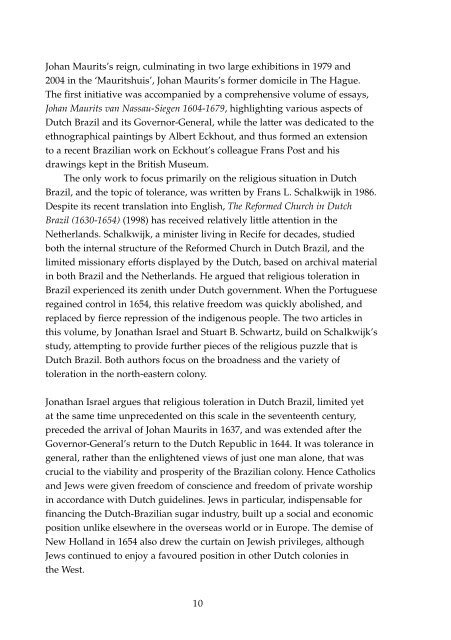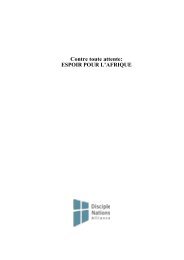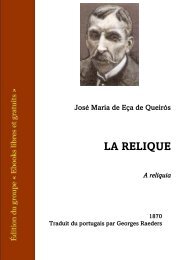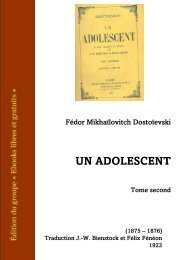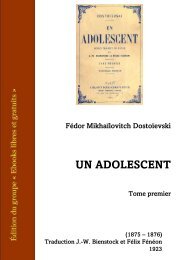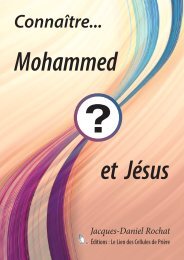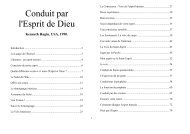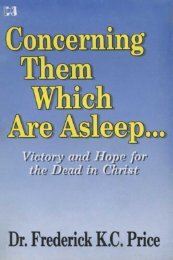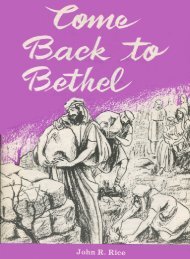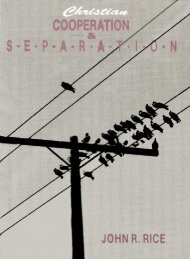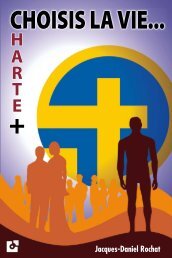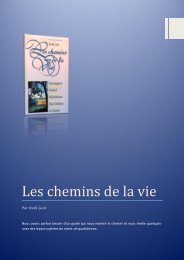The Expansion of tolerance
Create successful ePaper yourself
Turn your PDF publications into a flip-book with our unique Google optimized e-Paper software.
Johan Maurits’s reign, culminating in two large exhibitions in 1979 and<br />
2004 in the ‘Mauritshuis’, Johan Maurits’s former domicile in <strong>The</strong> Hague.<br />
<strong>The</strong> first initiative was accompanied by a comprehensive volume <strong>of</strong> essays,<br />
Johan Maurits van Nassau-Siegen 1604-1679, highlighting various aspects <strong>of</strong><br />
Dutch Brazil and its Governor-General, while the latter was dedicated to the<br />
ethnographical paintings by Albert Eckhout, and thus formed an extension<br />
to a recent Brazilian work on Eckhout’s colleague Frans Post and his<br />
drawings kept in the British Museum.<br />
<strong>The</strong> only work to focus primarily on the religious situation in Dutch<br />
Brazil, and the topic <strong>of</strong> <strong>tolerance</strong>, was written by Frans L. Schalkwijk in 1986.<br />
Despite its recent translation into English, <strong>The</strong> Reformed Church in Dutch<br />
Brazil (1630-1654) (1998) has received relatively little attention in the<br />
Netherlands. Schalkwijk, a minister living in Recife for decades, studied<br />
both the internal structure <strong>of</strong> the Reformed Church in Dutch Brazil, and the<br />
limited missionary efforts displayed by the Dutch, based on archival material<br />
in both Brazil and the Netherlands. He argued that religious toleration in<br />
Brazil experienced its zenith under Dutch government. When the Portuguese<br />
regained control in 1654, this relative freedom was quickly abolished, and<br />
replaced by fierce repression <strong>of</strong> the indigenous people. <strong>The</strong> two articles in<br />
this volume, by Jonathan Israel and Stuart B. Schwartz, build on Schalkwijk’s<br />
study, attempting to provide further pieces <strong>of</strong> the religious puzzle that is<br />
Dutch Brazil. Both authors focus on the broadness and the variety <strong>of</strong><br />
toleration in the north-eastern colony.<br />
Jonathan Israel argues that religious toleration in Dutch Brazil, limited yet<br />
at the same time unprecedented on this scale in the seventeenth century,<br />
preceded the arrival <strong>of</strong> Johan Maurits in 1637, and was extended after the<br />
Governor-General’s return to the Dutch Republic in 1644. It was <strong>tolerance</strong> in<br />
general, rather than the enlightened views <strong>of</strong> just one man alone, that was<br />
crucial to the viability and prosperity <strong>of</strong> the Brazilian colony. Hence Catholics<br />
and Jews were given freedom <strong>of</strong> conscience and freedom <strong>of</strong> private worship<br />
in accordance with Dutch guidelines. Jews in particular, indispensable for<br />
financing the Dutch-Brazilian sugar industry, built up a social and economic<br />
position unlike elsewhere in the overseas world or in Europe. <strong>The</strong> demise <strong>of</strong><br />
New Holland in 1654 also drew the curtain on Jewish privileges, although<br />
Jews continued to enjoy a favoured position in other Dutch colonies in<br />
the West.<br />
10


